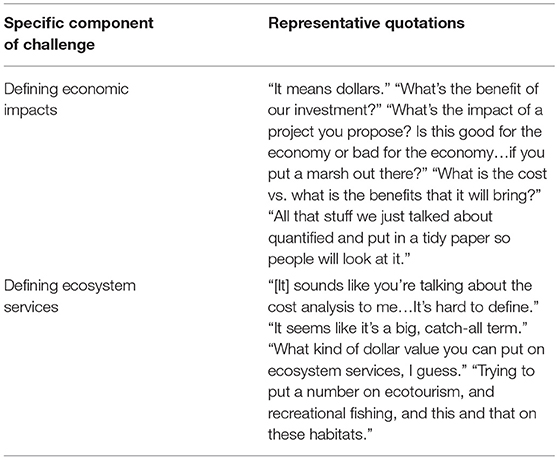NCCOS-funded researchers from six institutions report on insights and lessons learned from stakeholder engagement. The engagement was conducted during a multi-year transdisciplinary project focused on quantifying and communicating the benefits of natural and nature-based features. The findings indicate that economic impacts and ecosystem services topics can be challenging topics to communicate because of difficulty in understanding the terms and the economic valuation involved.

The study highlights major project findings, discusses implications and lessons learned, and offers practical guidance and future research recommendations. Above all, instead of using terms like “economic impact assessments/analysis” or “ecosystem services valuation,” the study recommends using “ecosystem services assessment,” a more accurate and understandable term, with stakeholders.
Natural and Nature Based Features (NNBFs) are landscape features (as opposed to traditional “hard” engineering structures) that provide engineering functions relevant to flood risk management while producing additional economic, environmental, and/or social benefits. Examples of NNBF include beaches and dunes; vegetated environments such as maritime forests, salt marshes, freshwater wetlands and fluvial flood plains, and seagrass beds; coral and oyster reefs, barrier islands, among others (see USACE/EWN).
An ecosystem services assessment (ESA) describes the intrinsic value of ecosystems via direct and indirect benefits that species and natural systems provide to human society, including flood protection, fisheries, water filtration, aesthetics, and tourism. An ESA recognizes both the integrated human (or built) environment and natural ecosystem and the holistic benefits provided by each.
As discussed in the study paper, an ESA accounts for and measures the value of the benefits received from natural systems; the measurement can be either monetary and/or non-monetary. A traditional cost-benefit analysis would include the benefits estimated from an ESA and compare those to the cost of undertaking a project (e.g., restoring a wetland). ESAs integrate bio-geo-physical and social-behavioral-economic data that can produce information to improve decision making. Both processes of developing ESAs and acting on their findings requires community negotiation and balancing multiple stakeholders’ needs.
Thus, facilitating effective discussions about ESA data with a range of audiences is crucial for coastal resilience. However, it can be complex and challenging due to lack of consistent terminology and differing conceptions of what ecosystem services or economic impacts involve. Researchers need a better understanding of how different stakeholders conceptualize, consider, and talk about ecosystem services and economic impacts to tailor model development and research products to their needs.
The study, published in the journal Frontiers in Communication, focused on the northern Gulf of Mexico coastal land-margin (Figure 1) that faces a complex array of socioeconomic challenges such as vulnerable industry, low per capita income, and low level of educational attainment. These socioeconomic issues are exacerbated by present and future bio-geo-physical challenges to critical local industries such as fishing, shrimping, and oystering, which are especially important in rural and low-income areas. In particular, rising sea levels will have significant impacts on coastal habitats critical for coastal protection and services.
A major project goal was to learn how to best demonstrate and communicate benefits of NNBFs through the lens of economic impacts and ecosystem services. To succeed in this endeavor, the project team needed to better understand the perspectives, experiences, and concerns of regional and local stakeholders regarding ESAs. The team gathered this information through various stakeholder engagement mechanisms (i.e., workshops, presentations, facilitated discussions, data exploration activities, focus groups, webinars with interactive polling, and evaluation surveys). The study reports primarily on the focus groups, but also incorporates connections to the other engagement techniques, reflections from our project experiences and team communication, and links to relevant literature.

The project scientists conducted four total focus groups between nine and twelve participants each during the project’s annual workshops in 2018 and 2019 at National Estuarine Research Reserve facilities in Grand Bay, Mississippi and Weeks Bay, Alabama. Focus group interviewing is a social science technique for gathering participant perspectives and comments that can strengthen scientist-stakeholder communication, build trust, and improve decision making and usability of scientific research and products. The project workshops’ purpose was to reiterate the project’s goals, provide updates on the research, and collect further stakeholder input on the project process and products.
The focus groups identified and discussed various challenges incorporating ESA in their activities, i.e., the perception that NNBFs can compound the methodological complexity and that it is easier to calculate direct economic benefits of traditional engineered structures like a seawall than indirect economic benefits of establishing an oyster reef (e.g., Table 1).
In summary, the challenges encountered within the project team and while engaging with stakeholders regarding economic impacts and ecosystem services related to NNBFs resulted in recognizing the utility of ESA terminology. The project team solidified their understanding and application of the concepts and methods and the stakeholder participants became more comfortable discussing ESA topics. Project success stemmed from recognition by all of the importance of ESA for building coastal resiliency and the need to better understand and incorporate interrelated natural and anthropogenic information into planning for present conditions and future changes.
This study involved researchers led by Louisiana State University and the Center for Coastal Resiliency with project partners from the University of Central Florida, Mississippi State University, Mississippi-Alabama and Florida Sea Grant, and Texas A&M University, Harte Research Institute for Gulf of Mexico Studies. The study was supported primarily through the NCCOS ESLR project Dynamic Sea Level Rise Assessments of the Ability of Natural and Nature-based Features to Mitigate Surge and Nuisance Flooding.
Citation: DeLorme, Denise E., Sonia H. Stephens, Renee C. Collini, David W. Yoskowitz and Scott C. Hagen. 2021. Communicating and Understanding Ecosystem Services Assessment With Coastal Stakeholders: Obstacles and Opportunities. Frontiers in Communication. https://doi.org/10.3389/fcomm.2021.656884
